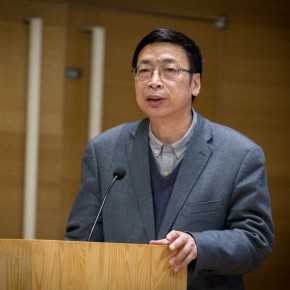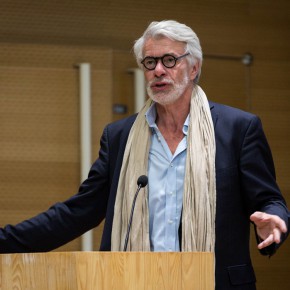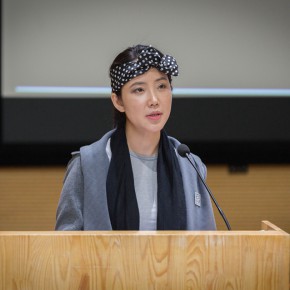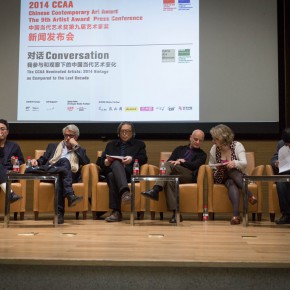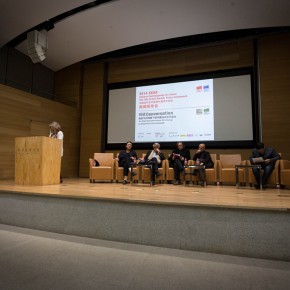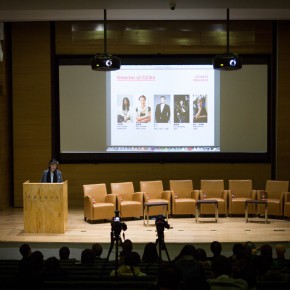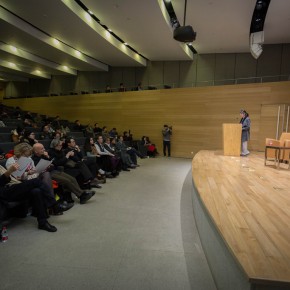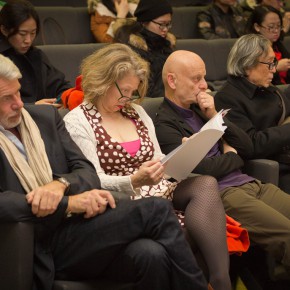
At 10:00 on November 14, 2014, CCAA Chinese Contemporary Art Award Press Conference was held in the Auditorium of CAFA Art Museum. The jury was composed of Doryun Chong (Chief Curator at M+ Hong Kong), Chris Dercon (Director of London’s Tate Modern), Gong Yan (Curator of Power Station of Art, Shanghai), Jia Fangzhou (well-known critic, curator), Ruth Noack (Curator of documenta 12), Uli Sigg (founder of CCAA), Yin Shuangxi (well-known critic, curator), the press conference announced the winners of the Artist Awards of the year – Annual Artist: Kan Xuan; Young Artist: Ni Youyu; Outstanding Achievement: Song Dong.
Director of CCAA Liu Lili initially introduced the history and awards origination in the CCAA Chinese Contemporary Art Award. Chinese Contemporary Art Award is specifically granted to Chinese artists and art critics demonstarting excellent talent in art exhibitions, in recognition of their outstanding creations and comments, and striving to help the public understand and appreciate Chinese contemporary art thus making a great contribution to contemporary Chinese culture.
At the press conference, the judge Ruth Noack announced the three award-wining artists, and then the judge Chris Dercon made a statement on the artists. He said that, the three winning artists were all interested in cultural protection. Indeed, in recent years, cultural protection had become a worldwide key cultural issue, what do we protect? How to protect it? What kind of protection? All of them were critical.
When Ruth Noack mentioned the winner of the “Outstanding Achievement” Song Dong, she said that, Song Dong had always been an indispensable part of Chinese contemporary art since the 1990s. His early work of single channel video to later behavior and photography are all appealing. In his work, it showcased the urban space, as well as an intense conversation betwee nindividuals, families and history and memories. It is worth mentioning that, Song Dong is maybe one of the youngest winners of the “Outstanding Achievement” by CCAA.
As the eldest judge Jia Fangzhou valued the winner of “Best Young Artist” Ni Youyu, although Ni Youyu was a young artist, his work already showcased a high degree of richness and unity, at the same time it conveyed the contemporary state of mind and traditional sensibility.
Yin Shuangxi said, “Best Artist” was awarded to the artist who made an outstanding contribution for contemporary art creation in the past two years, and the innovative work “Millet Mounds” by Kan Xuan won the prize of the year. The video installation described the tombs, monuments built in different dynasties and the current surrounding social landscapes left in Shanxi, Shaanxi, Henan, Shandong and other inland areas of China. Kan Xuan’s work made an effective statement about a large scale surgeand there was even a violent conversion between the ancient and current lands in China, and this was a rare case.
After that, Liu Lili, Director of CCAA announced the opening of the Sino-Foreign Forum entitled “Chinese Contemporary Art Vintage through My Participation and Observation”, invited the CCAA judges at home and abroad: Doryun Chong, Chris Dercon, Jia Fangzhou, Ruth Noack, Uli Sigg, Yin Shuangxi to attend the discussion.
Ruth Noack initially said she was surprised by the fast development of the quality and richness of the young Chinese artists. She believed that the characteristic of China’s new generation of artists was their in-depth knowledge of the international community, but they didn’t pay close attention to international events except in the context of localization. And now China had developed an excellent artistic state, art institution and market, with more museums, educational resources and related contents.
Uli Sigg asked the judges at home and abroad two questions: firstly how did they look upon contemporary art in China over the past decade; secondly they asked the Western judges a question that – seeing a large number of new works by the candidates over the year, whether they would consider joining the work into their projects in progress.
Jia Fangzhou thought the change of Chinese contemporary art was unfolding with two clues, on the one hand, more youths involved in the positioning of the state of globalization, their way of performance, thinking, artistic vision tended to be cosmopolitan; on the other hand, growing up with the local artistic basis, Chinese artists tried to convert the traditional art into contemporary.
Through the observation of young artists by the jury, Doryun Chong found that, young Chinese artists didn’t reflect a sense of insecurity like other contemporary artists, and they were the same with the young artists of the world. Chinese artists and the world had changed, the increased Chinese institutions could independently study the history of Chinese contemporary art, making Chinese art more confident, but it wasn’t an interpretation from the perspective of nationalism.
Chris Dercon took Tate Modern as example,in his view, as an art institution it must play a role in choosing living artists from the market and showcasing them, otherwise, the market would become the sole criterion; in addition, Tate Modern would not simply plan an exhibition about Chinese art, which was simply posting a label telling it was from “China” or “Chinese Art”.
Finally, Yin Shuangxi said, from the speeches of the international jury he had a feeling that Chinese contemporary art would be more unperturbed and develop independently, rather than passively waiting for international selection and care. He also suggested to the young artists that, “Young artists need to add historical and cultural content to the creation, rather than just to reflect personal experiences and a social documentary of the moment, although it is also important.”
Based on the experiences and changes in their participation and research of CCAA, Chinese and foreign judges of CCAA of the year unfolded a discussion from their individual perspectives, to discuss and think about the changing relationship between the development of Chinese contemporary art and the history of Chinese contemporary art.
Text by Lin Jiabin, translated by Chen Peihua and edited by Sue/CAFA ART INFO
Photo by Yang Yanyuan/CAFA ART INFO







